

 中文摘要:
中文摘要:
通过对以国产废纸为原料的造纸企业全封闭循环水中DCS(溶解和胶体物质)的组成及相关水质参数的调查,分析了DCS的积累及其与生产和水处理工序之间的内在联系,研究结果表明,DS(溶解物质)是废纸造纸循环水中DCS的主要组成成分,其含量占80%以上,是循环水电导率的主要贡献者,DS贡献的电荷值占DCS电荷值的90%以上;大于0.45μm的大分子胶体物质(CS)是影响浊度的主要成分。制浆工序出水中的DCS粒径分布峰值区域为0.4~0.5μm,造纸工序出水中的DCS粒径分布峰值区域为0.2~0.4μm,经厌氧生物处理单元的废水DCS粒径峰值区域减小到0~0.1μm,经好氧生物处理单元的废水DCS粒径峰值区域则增大至0.5~0.6μm。DCS及DS中的阳离子电荷需求量在厌氧处理单元有所下降,DS与DCS阳离子需求量的比值表现出最大值,说明在厌氧阶段对阴离子垃圾的去除效果明显。经过好氧处理后,DS和DCS中阳离子需求量以及两者浓度之比则呈上升趋势,说明好氧生物氧化后产生了大量中性的CS及带负电荷的DS。
 英文摘要:
英文摘要:
In this paper,the composition and accumulation characteristics of dissolved and colloidal substance(DCS) and the related parameters were investigated in the recycling water of a local recycled fiber mill with zero wastewater discharge,the internal relationships among these parameters were analyzed.The results showed that DS accounted for more than 80% of the DCS is the major components of the DCS,it is the main contributor to conductivity of the recycling water with 90% contribution to the charge value of DCS.Macromolecular colloid substances which diameter is bigger than 0.45 μm are the main components to affect turbidity of the water.The DCS diameter in wastewater discharged from pulping process is mainly distributed in the range of 0.4 μm to 0.5 μm.But which from paper-making process is mainly distributed from 0.2 μm to 0.4 μm.Then it is reduced to 0~0.1 μm after anaerobic unit,but increased to 0.5 μm~0.6 μm after aerobic unit.During the anaerobic treatment,the cationic charge demands of DS and DCS are decreased;the cationic charge demand ratio of DS/DCS shows the maximum value,which indicating that anionic trash removes evidently in anaerobic stage.However,DS,DCS,as well as the cationic charge demand ratio of DS/DCS increase after aerobic treatment,which can be interpreted that a large number of neutral CS and negatively charged DS are produced after aerobic oxidation.
 同期刊论文项目
同期刊论文项目
 同项目期刊论文
同项目期刊论文
 Optimization and Characterization of Lignin Biodegradation Process by a Bacterial Strain Sphingobact
Optimization and Characterization of Lignin Biodegradation Process by a Bacterial Strain Sphingobact Optimal Design of an Integrated Discontinuous Water-Using Network Coordinating with a Central Contin
Optimal Design of an Integrated Discontinuous Water-Using Network Coordinating with a Central Contin Determining the performance of an efficient non-aqueous CO2 capture process at desorption temperatur
Determining the performance of an efficient non-aqueous CO2 capture process at desorption temperatur Sharp Front Capturing Method for Carbon Dioxide Plume Propagation during Injection into a Deep Confi
Sharp Front Capturing Method for Carbon Dioxide Plume Propagation during Injection into a Deep Confi Characterizing the transport properties of multi-amine solutions for CO2 capture by molecular dynami
Characterizing the transport properties of multi-amine solutions for CO2 capture by molecular dynami Evolutionary Graphical Approach for Simultaneous Targeting and Design of Resource Conservation Netwo
Evolutionary Graphical Approach for Simultaneous Targeting and Design of Resource Conservation Netwo 期刊信息
期刊信息
